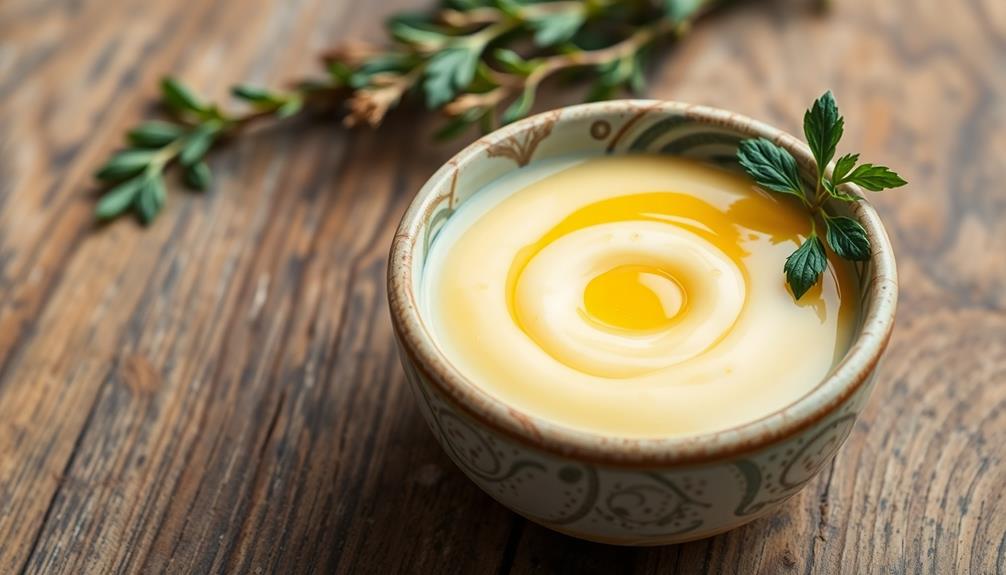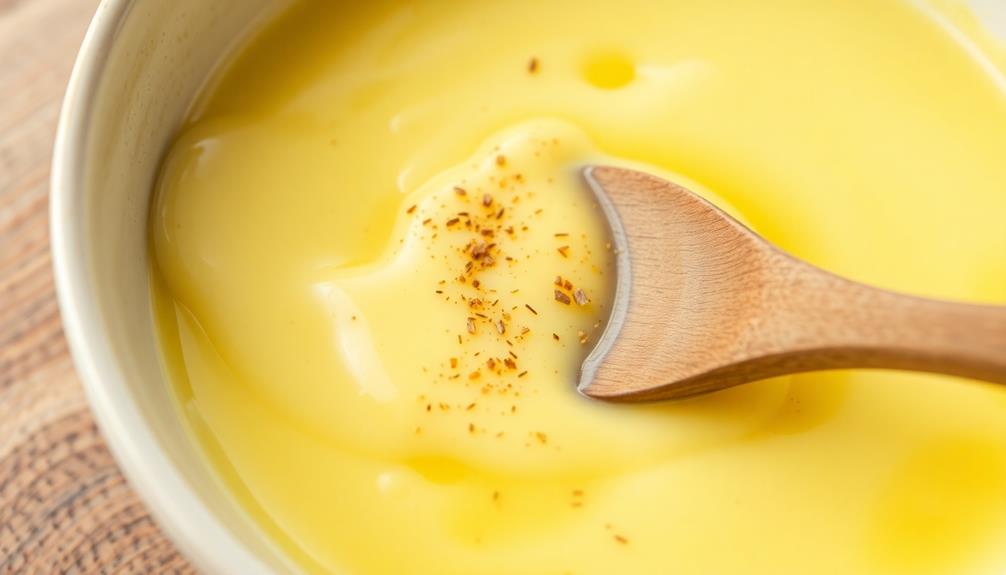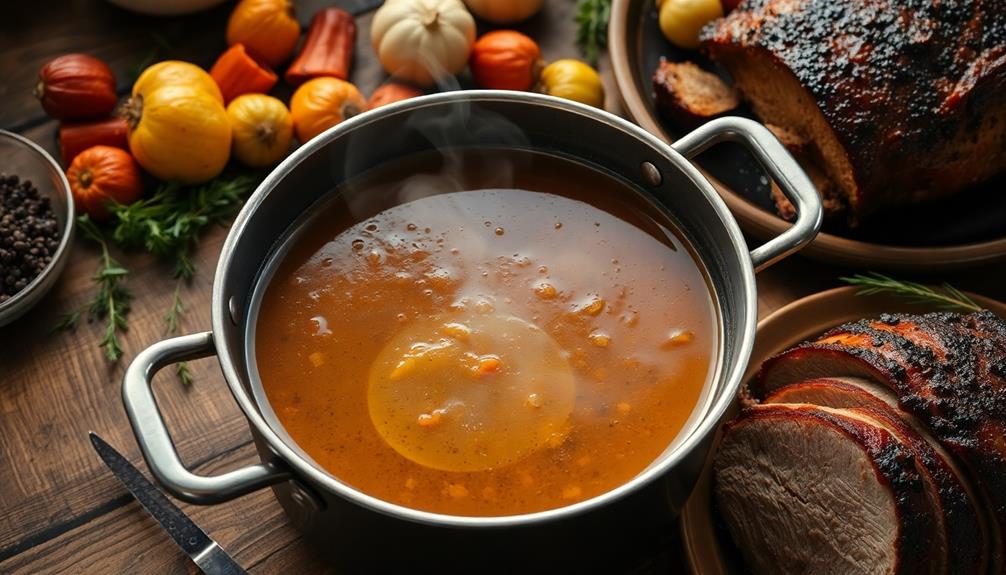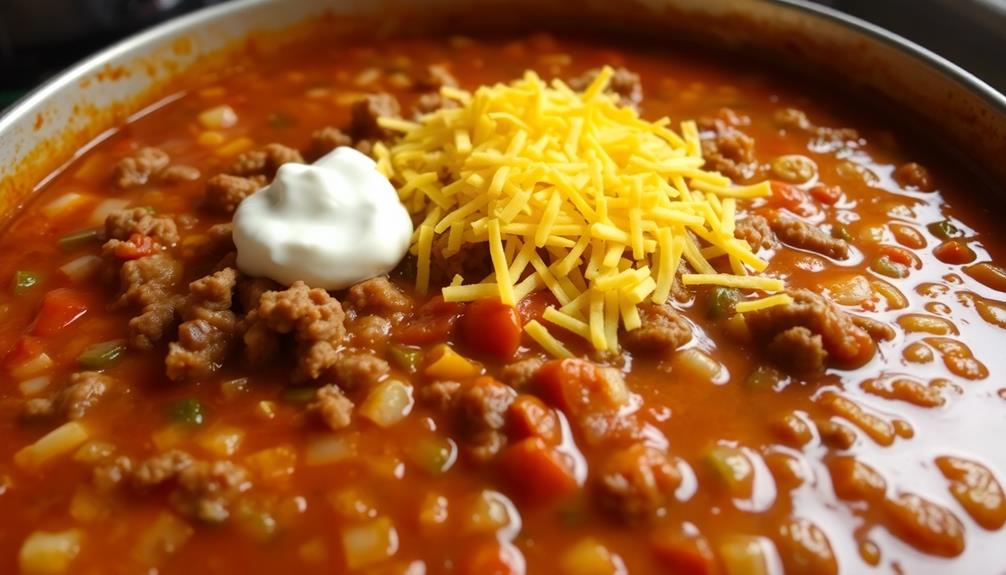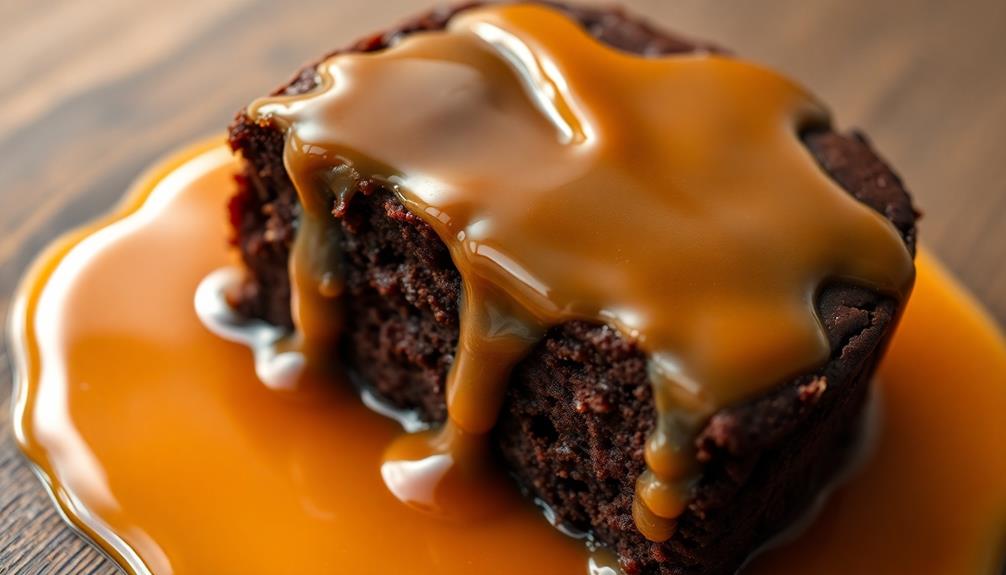Craft the perfect homemade mayonnaise with just a few simple ingredients! This versatile condiment originated in 18th-century France and has since become a culinary staple. Start by whisking together egg yolks, Dijon mustard, and lemon juice. Slowly drizzle in neutral oil while whisking vigorously to create a creamy emulsion. Adjust the consistency with additional oil or lemon juice as needed, and season with salt and pepper. Store the mayonnaise in an airtight container in the fridge for up to 5 days. Enjoy the superior taste and customizable flavors of homemade mayonnaise – it's sure to elevate your sandwiches, salads, and more. To learn even more creative ways to use this versatile condiment, keep reading.
Key Takeaways
- Combine egg yolks, Dijon mustard, and lemon juice, then slowly incorporate neutral oil to create a rich, emulsified homemade mayonnaise.
- Maintain room temperature for all ingredients and whisk vigorously to aid the emulsification process, resulting in the desired thick, creamy texture.
- Adjust the consistency by adding more oil for a thicker mayo or more lemon juice for a thinner version, and season with salt and pepper to taste.
- Store the homemade mayonnaise in an airtight container in the refrigerator for 3-5 days or freeze for 2-3 months for extended shelf life.
- Experiment with different oils, herbs, and spices to customize the flavor profile of the homemade mayonnaise to your preferences.
History
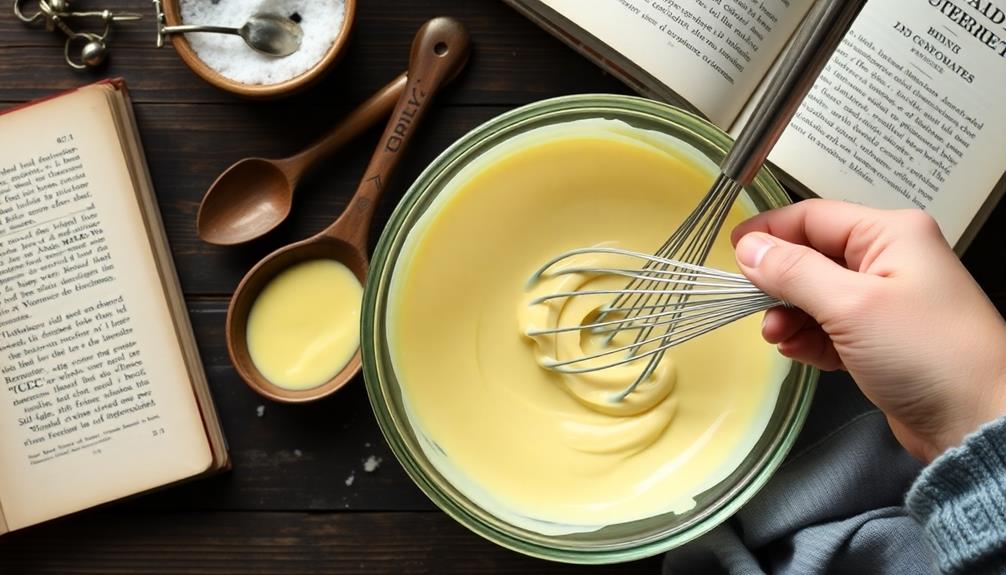
Tracing the origins of mayonnaise, the creamy condiment has long been a staple in culinary traditions across the globe. While its exact genesis is debated, many historians believe mayonnaise emerged in the 18th century from the French city of Mahón.
During the siege of the city by the French in 1756, the victorious commander, the Duke of Richelieu, celebrated with a feast featuring a sauce made from olive oil, egg yolks, and other ingredients – the precursor to modern mayonnaise.
From its French roots, mayonnaise spread throughout Europe and eventually the world, becoming a beloved condiment in sandwiches, salads, and more. Its versatility and rich, tangy flavor have made it a kitchen staple for generations.
Today, homemade mayonnaise remains a point of pride for many home cooks, who relish the opportunity to craft this classic condiment from scratch using just a few simple ingredients.
Whether dolloped on a burger or folded into a creamy dip, homemade mayonnaise offers an unparalleled taste experience. Its rich, velvety texture and customizable flavor make it a staple condiment that elevates even the simplest dishes. Making it from scratch can also be a fun culinary adventure for the whole family, much like exploring an easy cookie recipe for kids. Both activities bring joy to the kitchen while teaching valuable cooking skills everyone can enjoy.
Recipe
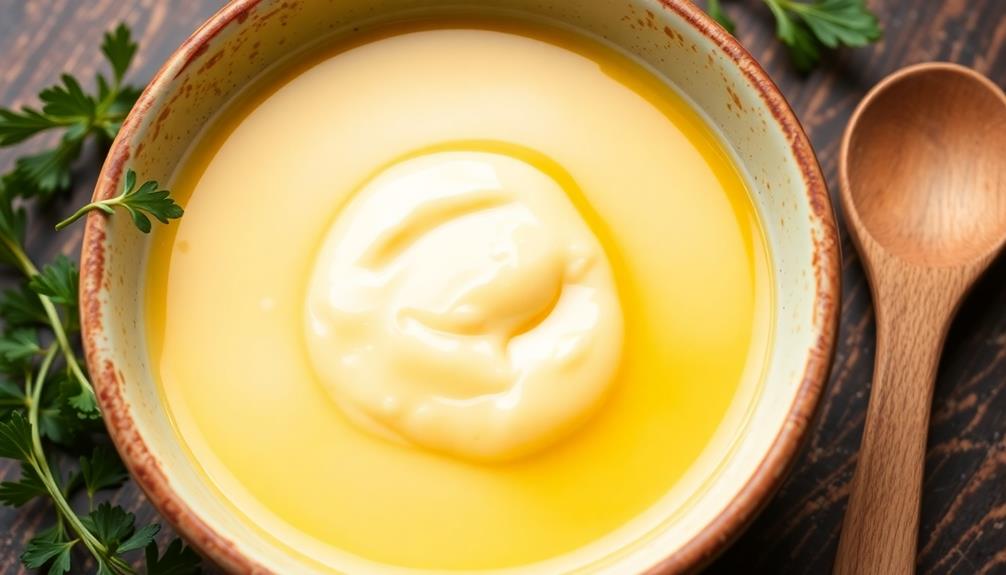
Homemade mayonnaise is a versatile condiment that can elevate a variety of dishes. Unlike store-bought versions, this recipe allows you to control the ingredients and create a creamy, flavorful mayonnaise that surpasses anything you can find on the shelves.
Mayonnaise is a simple emulsion of egg yolks, oil, and acid, such as lemon juice or vinegar. The key to success lies in slowly incorporating the oil while whisking vigorously to achieve the perfect texture. This process may seem daunting, but with a little practice, you'll be able to make mayonnaise with ease.
Ingredients:
- 2 large egg yolks
- 1 tablespoon Dijon mustard
- 1 tablespoon lemon juice
- 1 cup neutral-flavored oil (such as canola or grapeseed)
- 1/4 teaspoon salt
Instructions:
In a medium bowl, whisk together the egg yolks, Dijon mustard, and lemon juice until well combined.
Slowly, while continuously whisking, add the oil, a few drops at a time, until the mixture begins to thicken. Once it starts to emulsify, you can gradually increase the flow of oil, whisking constantly until all the oil has been incorporated and the mayonnaise is thick and creamy.
When making homemade mayonnaise, it's important to use fresh, high-quality ingredients and to work in a clean, cool environment. The temperature of the ingredients and the environment can affect the emulsion, so it's best to have all components at room temperature before beginning.
Additionally, if the mayonnaise starts to separate, you can try whisking in an extra egg yolk to help re-emulsify it. With a little practice, you'll be able to create a seamless, silky mayonnaise that will elevate your favorite dishes.
Cooking Steps
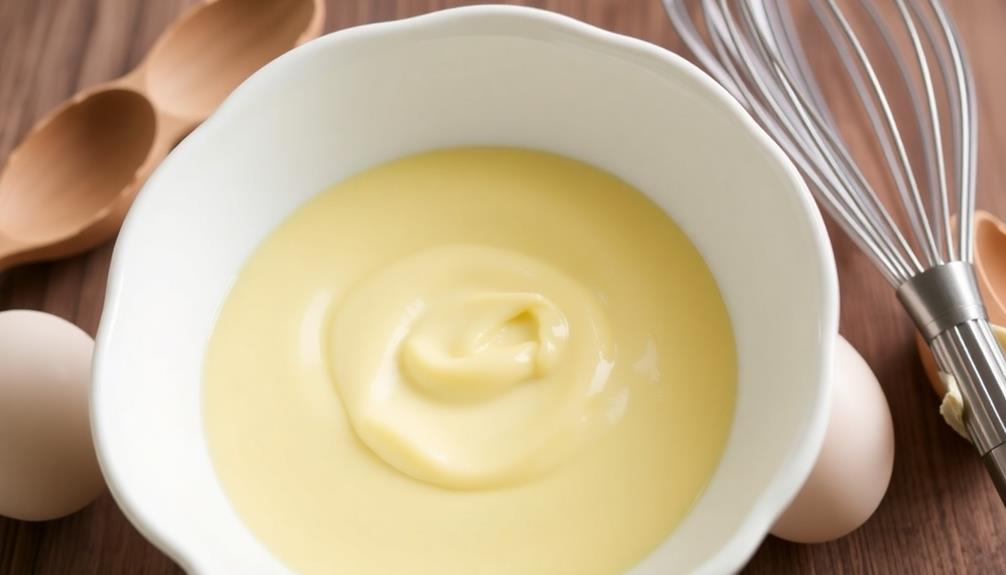
Whisk the egg yolks and lemon juice together in a bowl until thoroughly combined.
Slowly drizzle in the oil, whisking constantly, to create an emulsion. If the consistency gets too thick, add a bit more lemon juice to thin it out.
Once it's reached your desired texture, season the mayonnaise with salt and pepper to taste.
Step 1. Whisk Egg Yolks and Lemon Juice
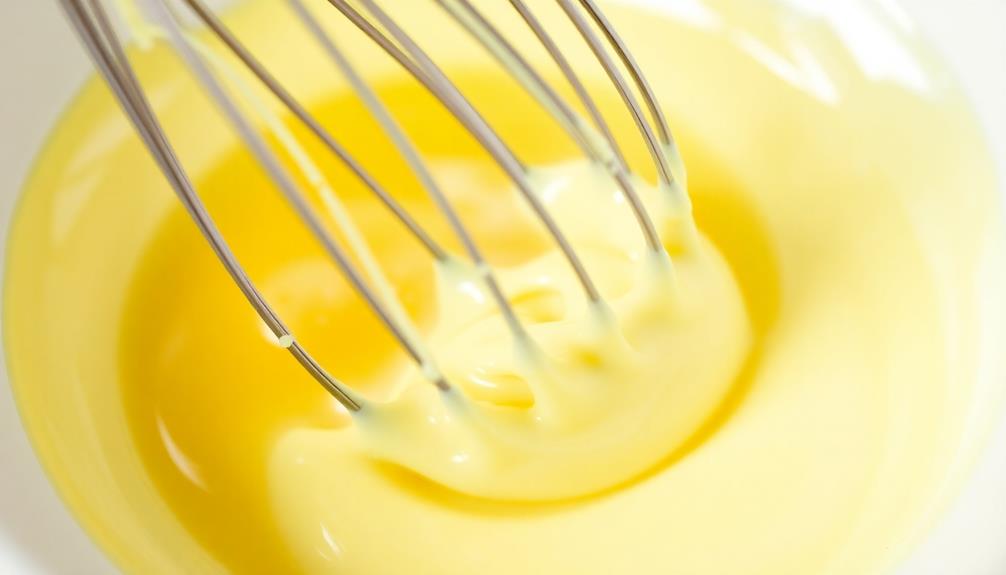
Begin by separating the egg yolks from the whites. You'll need the yolks for this step, so carefully crack the eggs and gently transfer the yolks to a small bowl, reserving the whites for another use.
Once you have the yolks, add the lemon juice and whisk the mixture together until it's smooth and well-combined.
Whisking the egg yolks and lemon juice is an essential step in making homemade mayonnaise. The lemon juice helps to emulsify the ingredients, creating that signature creamy texture.
Whisk the mixture vigorously, making sure to incorporate air to help the mayo thicken up. Keep whisking until the mixture becomes light and frothy. This should take about 1-2 minutes of steady whisking.
Be patient and keep at it – you'll know you've done it right when the mixture has thickened and lightened in color.
Step 2. Slowly Drizzle in Oil
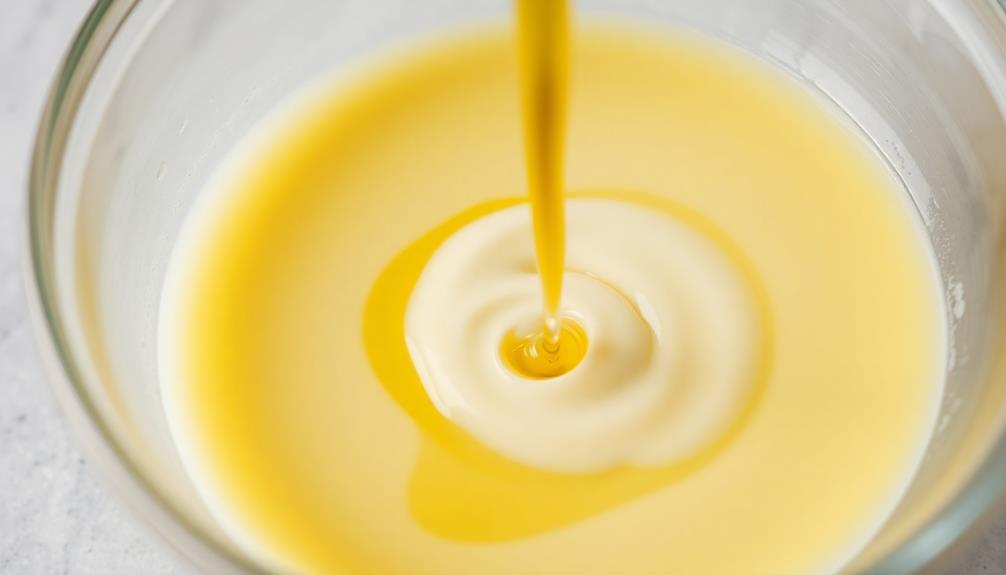
Slowly drizzling in the oil is the next crucial step in creating your homemade mayonnaise. This process requires your full attention, as the oil must be added in a slow, steady stream to ensure the emulsion forms properly.
Begin by selecting a neutral-flavored oil, such as grapeseed or canola, as these have a mild taste that won't overwhelm the other ingredients.
With your whisk in hand, start by adding just a few drops of oil to the egg yolk and lemon juice mixture. Whisk vigorously, incorporating the oil completely before adding a bit more. Gradually increase the rate of oil addition, but be sure to keep the stream very thin and the whisking consistent.
The mayonnaise will begin to thicken and emulsify as the oil is slowly incorporated.
Continue this process, drizzling in the oil and whisking continuously, until you have added all the oil and the mayonnaise has reached your desired consistency. Resist the urge to rush, as patience is key to achieving a creamy, homogeneous mayonnaise.
Step 3. Adjust Emulsion Consistency as Needed
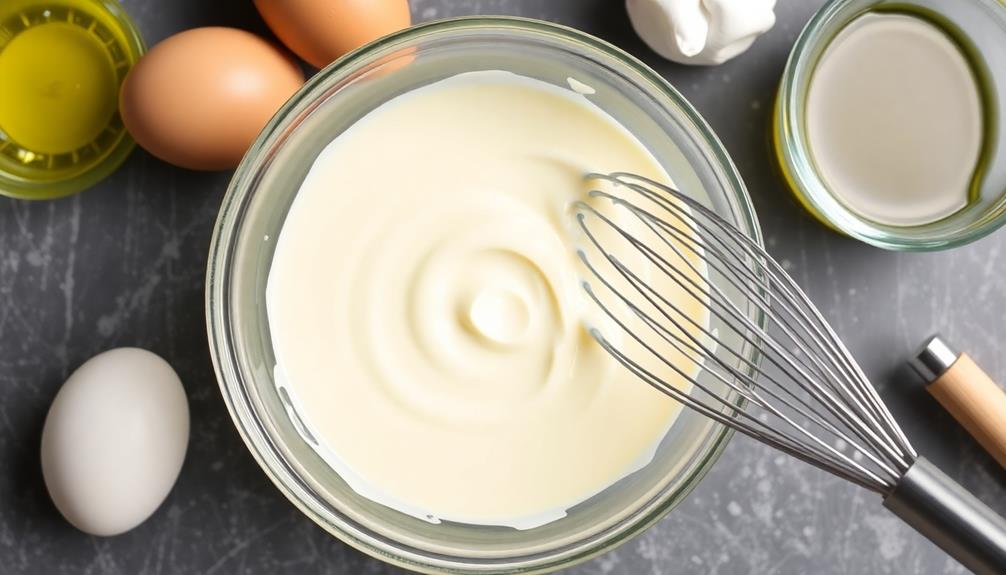
Once you've slowly incorporated all the oil, you'll want to check the consistency of your mayonnaise. It should have a thick, creamy texture, similar to store-bought mayo.
If it's too thin, you can thicken it up by continuing to slowly drizzle in a small amount of oil while the mixer is running. Conversely, if the mayonnaise is too thick, you can thin it out by adding a teaspoon or two of the reserved lemon juice or water.
Keep in mind that the final consistency will also depend on factors like the temperature of your ingredients and the speed at which you added the oil.
If the mayo seems a bit too stiff, don't be afraid to add a splash of water to loosen it up. The key is to adjust the consistency until it reaches your desired texture.
With a little practice, you'll be able to achieve the perfect homemade mayonnaise every time.
Step 4. Season With Salt and Pepper
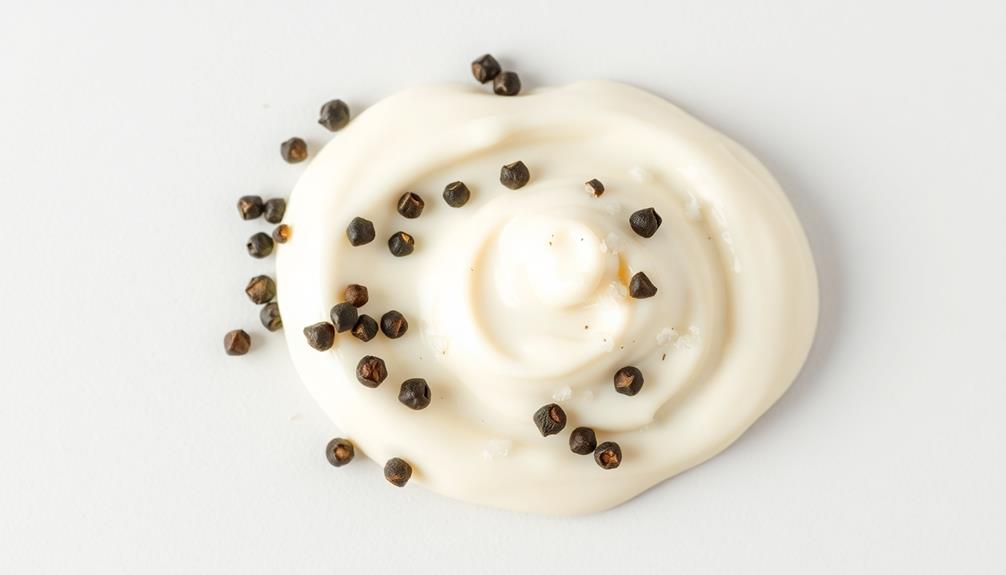
With the emulsion now at your desired consistency, season the mayonnaise with salt and pepper to taste. Start with a small amount of each, stirring well to incorporate. Taste and add more as needed, adjusting the flavors until they're just right.
When seasoning, keep in mind that the saltiness and peppery kick should complement the rich, creamy texture of the mayonnaise. Too little seasoning will result in a bland spread, while too much can overpower the delicate mayonnaise flavor.
For a classic flavor profile, aim for around 1/4 teaspoon of salt and 1/8 teaspoon of freshly ground black pepper per cup of mayonnaise.
You can also experiment with other spices, such as smoked paprika or garlic powder, to create unique variations. Just be sure to taste as you go, adding small amounts at a time until the seasoning is perfectly balanced.
Step 5. Transfer to Storage Container
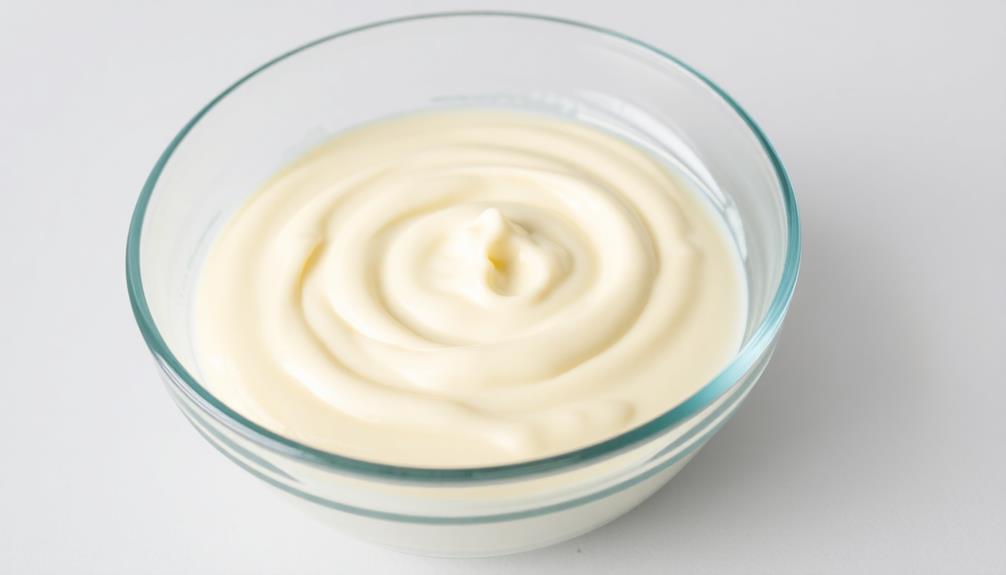
Your freshly made homemade mayonnaise is now ready to transfer into a storage container. To do this, use a rubber spatula to gently scrape the mayonnaise from the bowl into an airtight container, such as a glass jar or plastic tub. Be sure to leave a small amount of headspace at the top to allow for expansion.
If you plan to use the mayonnaise within the next few days, you can store it in the refrigerator. Otherwise, it's best to freeze the mayonnaise for longer-term storage. To freeze, simply transfer the mayonnaise to a freezer-safe container, leaving a bit of room at the top for expansion.
When ready to use, thaw the mayonnaise in the refrigerator overnight.
Regardless of whether you refrigerate or freeze the mayonnaise, be sure to label the container with the date it was made. Homemade mayonnaise typically lasts 3-5 days in the refrigerator and up to 2-3 months in the freezer.
Final Thoughts
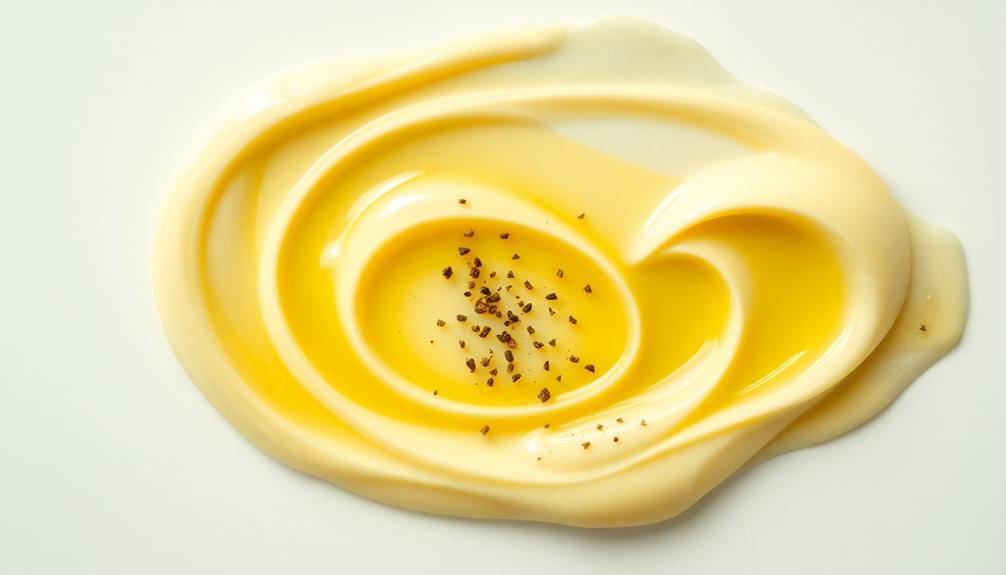
Making homemade mayonnaise may seem daunting, but the payoff is well worth the effort. Not only does it taste significantly better than store-bought, but you'll also have the satisfaction of crafting it yourself.
Plus, you can customize the flavor to your liking, whether that's adding a hint of garlic, a touch of lemon, or experimenting with different types of oils.
While the process may take some practice, don't be discouraged. With a little patience and the right techniques, you'll be whipping up perfect batches of homemade mayonnaise in no time.
Remember to follow the recipe closely, especially when it comes to the order and timing of the ingredients. And always be mindful of food safety, ensuring that your workspace and utensils are clean.
Enjoy your homemade mayonnaise and savor the fresh, creamy goodness. It's a truly rewarding experience that will elevate your culinary creations and impress your friends and family. Plus, with this simple homemade mayonnaise recipe, you can easily customize the flavor by adding herbs, garlic, or a hint of lemon zest. Not only is it free from preservatives, but it also offers a rich, natural taste that store-bought versions just can’t match. Once you’ve tried it, you’ll never go back!
Frequently Asked Questions
Can I Use Olive Oil Instead of Vegetable Oil?
Yes, you can use olive oil instead of vegetable oil. Olive oil has a distinct flavor that may alter the taste of the final product, but it can work as a substitute in many recipes.
How Long Does Homemade Mayonnaise Last in the Refrigerator?
Homemade mayonnaise typically lasts 3-5 days in the refrigerator when stored properly in an airtight container. The exact shelf life can vary depending on the ingredients used and how well it's been chilled.
Can I Make Mayonnaise With a Hand Mixer Instead of a Blender?
Yes, you can make mayonnaise with a hand mixer instead of a blender. The process may take a little longer, but you can achieve the same creamy texture using a hand mixer.
What Can I Do if My Mayonnaise Doesn't Emulsify Properly?
If your emulsion doesn't come together, don't worry! Try slowly drizzling in more oil while whisking vigorously. You can also try adding an extra egg yolk or a teaspoon of lemon juice to help stabilize the mixture.
Can I Add Additional Flavors to the Basic Mayonnaise Recipe?
You can certainly add additional flavors to your basic mayonnaise recipe. Try incorporating garlic, herbs, spices, or even a hint of citrus to create your own unique and flavorful mayonnaise. Experiment and find the combination that suits your taste preferences.
